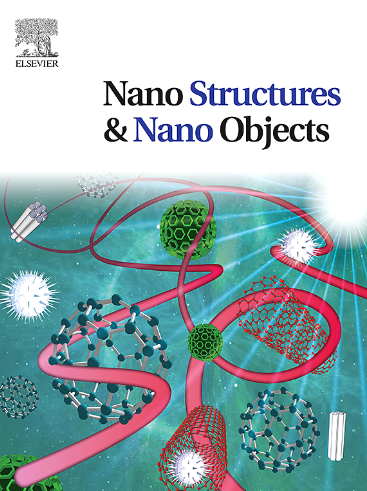Sustainable synthesis and application of green deep eutectic solvent in chalcopyrite leaching: A combined experimental and molecular dynamic simulation approach
IF 5.45
Q1 Physics and Astronomy
引用次数: 0
Abstract
In this study, the chemical dissolution of chalcopyrite in a deep eutectic solvent (DES) solvent with a combination of choline chloride (ChCl) and maleic acid (MA) was investigated. Using the Taguchi experimental design, three parameters were optimized: leaching time (2–24 h), leaching temperature (100–200 °C), and the mol ratio of ChCl to MA (1:2, 1:1, and 2:1). The results of the Taguchi design showed that increasing temperature and time enhances copper recovery. Under optimal conditions for dissolving chalcopyrite at a ChCl:MA ratio of 1:1, with a leaching temperature of 150 °C and a leaching time of 24 h, copper recovery was approximately calculated as about 49.2 %, which is relatively consistent with experiment results showing 52.6 %. Under optimal conditions, XRD and SEM-EDS analyses of leaching residues show no sulfur film formation on chalcopyrite surfaces. Instead, they indicate elevated levels of SiO2, FeS2, and CuS, suggesting these phases have limited solubility in DES. Combining ChCl and MA forms a DES with altered infrared spectra due to hydrogen bonding, allowing for stable reuse after metal separation via precipitation or electrolysis methods. Cyclic voltammetry (CV) results show that chalcopyrite dissolution in DES is a chemical process, occurring without oxidation reactions. Molecular dynamic (MD) simulations explored interactions in an MA and ChCl DES. Radial distribution function (RDF) analysis revealed strong interactions between MA's hydroxyl hydrogens as well as ChCl's chloride, and intramolecular hydrogen bonds within MA. Simulations also showed Cu2+ and Fe2+ ions interact strongly with chloride ions of ChCl and oxygen atoms of MA, with low diffusion coefficients suggesting a 3D hydrogen bond network.
绿色深共晶溶剂在黄铜矿浸出中的可持续合成与应用:实验与分子动力学模拟相结合的方法
本文研究了黄铜矿在氯化胆碱(ChCl)和马来酸(MA)的深度共熔溶剂(DES)中的化学溶解。采用田口试验设计,对浸出时间(2 ~ 24 h)、浸出温度(100 ~ 200℃)、ChCl与MA的物质比(1:2、1:1、2:1)三个参数进行优化。田口设计的结果表明,增加温度和时间可以提高铜的回收率。在ChCl:MA比为1:1、浸出温度为150℃、浸出时间为24 h的最佳条件下,铜回收率约为49.2 %,与实验结果52.6% %较为吻合。在最佳条件下,对浸出渣的XRD和SEM-EDS分析表明,黄铜矿表面未形成硫膜。相反,它们表明SiO2、FeS2和cu的含量升高,表明这些相在DES中的溶解度有限。ChCl和MA结合形成的DES由于氢键而改变了红外光谱,可以在通过沉淀或电解方法分离金属后稳定地重复使用。循环伏安法(CV)结果表明,黄铜矿在DES中的溶解是一个化学过程,不发生氧化反应。分子动力学(MD)模拟研究了MA和ChCl DES的相互作用。径向分布函数(RDF)分析揭示了MA的氢氧根和ChCl的氯离子之间的强相互作用,以及MA分子内的氢键。模拟还表明,Cu2+和Fe2+离子与氯离子ChCl和MA的氧原子相互作用强烈,具有较低的扩散系数,表明存在三维氢键网络。
本文章由计算机程序翻译,如有差异,请以英文原文为准。
求助全文
约1分钟内获得全文
求助全文
来源期刊

Nano-Structures & Nano-Objects
Physics and Astronomy-Condensed Matter Physics
CiteScore
9.20
自引率
0.00%
发文量
60
审稿时长
22 days
期刊介绍:
Nano-Structures & Nano-Objects is a new journal devoted to all aspects of the synthesis and the properties of this new flourishing domain. The journal is devoted to novel architectures at the nano-level with an emphasis on new synthesis and characterization methods. The journal is focused on the objects rather than on their applications. However, the research for new applications of original nano-structures & nano-objects in various fields such as nano-electronics, energy conversion, catalysis, drug delivery and nano-medicine is also welcome. The scope of Nano-Structures & Nano-Objects involves: -Metal and alloy nanoparticles with complex nanostructures such as shape control, core-shell and dumbells -Oxide nanoparticles and nanostructures, with complex oxide/metal, oxide/surface and oxide /organic interfaces -Inorganic semi-conducting nanoparticles (quantum dots) with an emphasis on new phases, structures, shapes and complexity -Nanostructures involving molecular inorganic species such as nanoparticles of coordination compounds, molecular magnets, spin transition nanoparticles etc. or organic nano-objects, in particular for molecular electronics -Nanostructured materials such as nano-MOFs and nano-zeolites -Hetero-junctions between molecules and nano-objects, between different nano-objects & nanostructures or between nano-objects & nanostructures and surfaces -Methods of characterization specific of the nano size or adapted for the nano size such as X-ray and neutron scattering, light scattering, NMR, Raman, Plasmonics, near field microscopies, various TEM and SEM techniques, magnetic studies, etc .
 求助内容:
求助内容: 应助结果提醒方式:
应助结果提醒方式:


